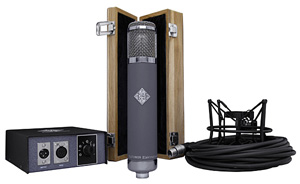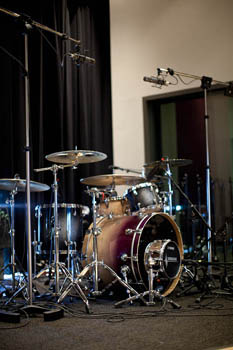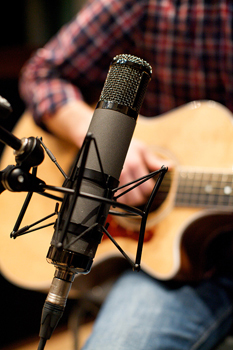Review: Telefunken R-F-T AR-51 Microphone
A few weeks ago, having the good fortune to escape the latest onslaught of snow to pummel NYC, I flew down to Lexington, KY to record a project at my familiar haunt and near second home, Saint Claire Recording Company .
I was producing and engineering an EP for a talented young singer/songwriter, Seth Abram, and his band.
As luck would have it, not only did I get a break from the snow and have an awesome studio at my fingertips, but I also had a pair of brand-new Telefunken AR-51s to test drive during the recording of this EP.
I was especially looking forward to taking these mics for a spin at Saint Claire, since the studio owns its own heavyweight – the widely acclaimed Telefunken ELA M 251 reissue. As the AR-51 is said to be a marriage between the amplifier electronics of a C-12 and ELA M 251E, and a globally sourced capsule and power supply, I couldn’t wait to see how these mics would stand up against the best of the best.
TECH SPECS: The AR-51 is a large diaphragm tube condenser mic powered by dedicated external power supply (included). Controlled from the power supply are three main polar patterns: Omni, Cardioid, and Figure 8 with six intermediate stages. The tube is a NOS (new old stock) ECC81 twin triode – the same tube found in Telefunken’s C12 and ELA M 251E.
Telefunken’s R-F-T series of microphones has been designed to ease the price burden normally associated with microphones of this stature by offering off-shore built capsules and power supplies (tested in the U.S. prior to installation) with the same excellent amplifier electronics used in their more expensive models. At a street price of $1,895, the AR-51 is virtually 1/5th the cost of Telefunken’s highest-end microphones.
IN USE: I will mention first off here that one of my favorite features of this mic is the XLR-style snapping cable lock that connects the power supply cable to the mic. This is a breath of fresh air for any engineer who has used a screw-in style cable for any number of external power supplied mics. This feature alone will save the owner of this mic several days of down time due to repair over the life of the mic.
The AR-51 is billed as an all around utility mic capable of reproducing brilliant sound on an endless number of sound sources. In my six days of tracking, I was never convinced of anything less.
Although the AR-51 and Saint Claire’s ELA M 251 we’re never tested side by side, I was thrilled and pleasantly surprised at just how close the AR-51 sounded to the ELA M251 from my listening tests with other recent projects tracked through the studio’s mic.
The body of the mic is extremely solid with a slightly textured finish and feels sturdy yet less heavy and bulky than its big brother, the 251. Having a pair of them at my disposal, my first move was to set them up over the kit for the first two days of rehearsal and basic tracking with the band. I was immediately impressed.
The mics were placed in a spaced pair approximately three feet above the drum kit. I was blown away by the warm yet punchy sound that greatly covered not just the cymbals, but the snare, toms and even a healthy amount of kick drum just from the overheads.
Hear an MP3 sample of the AR-51 overheads, captured at Saint Claire Recording, via Calrec 1061 -> UREI 1178:
“AR-51 Overheads” before
While this type of coverage may not be ideal for every engineer or style of music, for a big rock sound, they do a brilliant job. Coupled with a vintage pre amp and stereo compressor, the foundation of my drum sound on this record was built completely around the sound of these mics and their coverage on the kit.
Once we wrapped basic tracking, I made sure my assistant knew to leave at least one AR-51 up to shoot out with virtually every sound source we had left to cover on the project from acoustic and electric guitars to cello and percussion.
Hear an MP3 sample of the AR-51 on Acoustic Guitar tracked via Martech MSS-10 -> Neve 33609:
“Acoustic Guitar” before
Pointed at the 12th fret approximately 18” off the guitar, the mic translated excellently providing a sharp and crystal-clear tone with a healthy amount of tube saturation and warmth. There’s plenty of room for EQ with close-up sound sources as the AR-51 provides more than enough low-end but not so much that it’s overwhelming the source.
Male rock vocals shine on the AR-51 with terrific clarity and slight grit. The proximity effect on vocals was very noticeable allowing the deepest and most pleasant aspects of male vocals to stand out. The noise floor is extremely low allowing for the quietest whispers to come through. High SPL is also not a problem as the mic handled the most vocally dynamic songs from top to bottom without any adjustments at the preamp.
We were all especially excited to listen to the AR-51 on cello as one of the songs on the record was arranged for five separate parts, allowing for every element of the instrument to shine.
The mic was placed about two feet away fairly low on the instrument slightly above the F hole. Coupled with a room mic further back in the room, the AR-51 was a remarkable spot mic for cello providing deep, dramatic low end and just enough bow and string air. I’m not even sure we even bothered checking the second mic we had up as we were under a time crunch and everyone in the room seemed more than pleased with the sound.
Finally, on percussion, the AR-51 provided sharp and clear percussive tracks from shakers and tambourines, and even a little more cowbell baby! Preamp adjustments were minute between instruments as the majority of the level adjustments were accomplished with the player simply moving closer or further away from the mic.
TO BE CRITICAL… My assistant and I both found that while the included clasp-lock shock mount did the job of holding the mic very well with no discernible problems, we were both a little off-put by the general feeling that the shock mount wasn’t as durable and high quality as we were expecting perhaps due to the thin and very flexible feel. Besides our initial trepidation with the shock mount, I honestly had very little to be critical of here!
WRAPPING UP: I couldn’t be more impressed with the overall quality and versatility of the AR-51. At a price point that could easily be misconstrued as an imitation version of their more expensive products, the AR-51 competes on the same plane as everything else in Telefunken’s line hands down.
While these mics will certainly still be a stretch of the budget for a number of studios and engineers (myself included!) they are easily one of the best options in their class for anyone looking to marry world-class quality with a price point that’s within reach.
Click for more information or to purchase a Telefunken AR-51.
Zach McNees is a Brooklyn-based producer/engineer/mixer and live recordist who’s worked with Bjork, Rob Thomas, The Gregory Brothers, Pixies, Liars and Alice Cooper. Get in touch with Zach via http://www.zachmcnees.com.
Please note: When you buy products through links on this page, we may earn an affiliate commission.











Aron Blue
February 23, 2011 at 7:02 pm (14 years ago)Even though “its release just happened to coincide with the discontinuation of the M-16 mkII” (h/t gearslutz), so far my favorite thing about this mic is that it makes the m-16 mark ii a collectors item lol. seriously i’d like to see a comparison between the two of them
Zach McNees
March 9, 2011 at 3:58 am (14 years ago)I haven’t heard that M-16. I agree it would be an interesting shootout! I was really impressed with the 51 though.